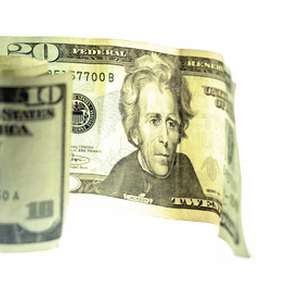
Breakdown
In 2007, the U.S. Census Bureau reported that the average family spent about $6,100 on food, $3,465 of which was spent at home. Of this, the average family spent $777 on meat and poultry, $387 on dairy products, $600 on fruits and vegetables and $1,200 on other items. This breaks down to about $64 per month for meat, $32 for dairy products, $50 for fruits and vegetable and $100 for other items. Not included in the food totals were average expenditures for alcoholic beverages, which cost the typical household about $450 per year.
Considerations

How much a family has to spend influences the amount of money it spends on food. According to the Census, families that earned less than $70,000 per year in 2007 spent an average of $4,625. Families that earned between $70,000 and $80,000 spent an average of $7,541. Families with earnings above $80,000 spent about $8100 annually.
History

The amount of money Americans spend on food, and government surveys about food budgets, play a role in how Americans have defined poverty. The official U.S. government definition of poverty was developed in the 1960s by a former researcher from the U.S. Department of Agriculture. Back then, the government believed that food expenditures accounted for about 30 percent of the household budget. It also had recommended budgets for families who wanted to be thrifty or spend liberally. To determine the poverty line in the 1960s, the government took its most basic food budget -- the kind a family experiencing short-term financial hardships would have -- and multiplied by three, giving us the poverty level. Those thresholds are adjusted annually to account for inflation. In 2007, a typical family spent about 12 percent of their budget on food, according to the Census.
Benefits

Those basic food plans still exist today, and the USDA updates them on a fairly regular basis. While Census and BLS data give an idea of how much Americans have spent, the USDA data tell us how much, or how little, Americans can spend. These sample budgets might be useful for families looking to reduce their monthly expenses. The publication is known as the USDA's Low Cost, Moderate Cost and Liberal Food plans. A separate publication is the Thrifty food plan, which features the expenditures expected of families in poverty. According to the USDA, "the Department of Defense uses the value of the Liberal Food Plan to determine the Basic Allowance for Subsistence rates for all service members. Many divorce courts use the values of the USDA Food Plans to set alimony payments."
Features

Under the USDA's low cost plan in 2008, an adult male between 19 and 50 years old should spend about $48.50 per week on food. It's about $6 less for women. Under that, a man would be expected to eat about 3 lbs. of grains such as bread, 9 lbs. of vegetables, 8 lbs. of fruit, 11 lbs. of dairy products such as milk, cheese and butter, 3 lbs. of meat or beans and 6 lbs. of other foods, including a whopping 4 lbs. of soft drinks. Women on the low-cost food budget might be expected to eat 3 lbs. of grains, 7 lbs. of vegetables, 8 lbs. of fruit and 12 lbs. of dairy products, 3 lbs. of meat and 5 lbs. of "other" foods -- most of which, according to the tables, is soda.
References
- Slate: How the Feds Define Poverty
- U.S. Census: Average Annual Expenditures of All Consumer Units
- US Census: Average Annual Expenditures of All Consumer Units
- USDA: Low Cost, Moderate Cost and Liberal Food Plans
- USDA: Official USDA Food Plans: Cost of Food at Home at Four Levels,
- Bureau of Labor Statistics: Average Consumer Expenditures
- Food and Nutrition Service. "SNAP Data Tables, Latest Available Month July 2019 State Level Participation & Benefits," Accessed Oct. 21, 2019.
- U.S. Department of Agriculture. "Official USDA Food Plans: Cost of Food at Home at Four Levels, U.S. Average, August 2019," Accessed Oct. 21, 2019.
- Center on Budget and Policy Priorities. "A Quick Guide to SNAP Eligibility and Benefits," Accessed Oct. 21, 2019.
- USDA." What Can SNAP Buy?" Accessed Oct. 21, 2019.
Writer Bio
Philadelphia-based freelancer Pat Kelley has been writing since 2002, most recently for Scripps Texas Newspapers. He has won numerous awards for reporting. He holds a Bachelor of Arts in political science.

